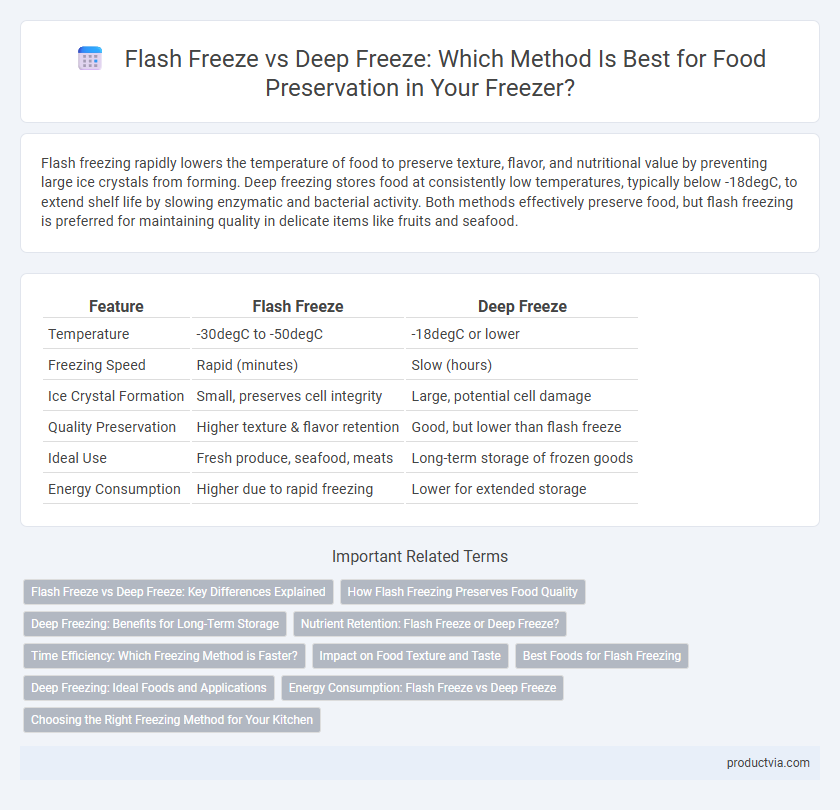Flash freezing rapidly lowers the temperature of food to preserve texture, flavor, and nutritional value by preventing large ice crystals from forming. Deep freezing stores food at consistently low temperatures, typically below -18degC, to extend shelf life by slowing enzymatic and bacterial activity. Both methods effectively preserve food, but flash freezing is preferred for maintaining quality in delicate items like fruits and seafood.
Table of Comparison
| Feature | Flash Freeze | Deep Freeze |
|---|---|---|
| Temperature | -30degC to -50degC | -18degC or lower |
| Freezing Speed | Rapid (minutes) | Slow (hours) |
| Ice Crystal Formation | Small, preserves cell integrity | Large, potential cell damage |
| Quality Preservation | Higher texture & flavor retention | Good, but lower than flash freeze |
| Ideal Use | Fresh produce, seafood, meats | Long-term storage of frozen goods |
| Energy Consumption | Higher due to rapid freezing | Lower for extended storage |
Flash Freeze vs Deep Freeze: Key Differences Explained
Flash freeze rapidly lowers food temperature to -30degC or lower, preventing large ice crystals and preserving texture and nutrients, ideal for fruits, vegetables, and seafood. Deep freeze maintains food at consistently low temperatures around -18degC, providing long-term storage but may cause larger ice crystal formation, potentially affecting texture. Flash freezing is preferred for maintaining cellular integrity, while deep freezing is more suitable for bulk food preservation.
How Flash Freezing Preserves Food Quality
Flash freezing preserves food quality by rapidly lowering the temperature to quickly freeze the food, preventing large ice crystals from forming that can rupture cell walls and degrade texture. This method locks in nutrients, flavor, and color more effectively than deep freezing, which freezes food more slowly and may cause quality loss over time. Flash freezing is widely used in the seafood and fruit industries to maintain freshness during extended storage and transportation.
Deep Freezing: Benefits for Long-Term Storage
Deep freezing food preserves nutritional value and texture better than other methods by quickly lowering temperatures to around -18degC or lower, effectively halting microbial growth and enzymatic activity. This method extends shelf life for months or even years, making it ideal for long-term storage of meats, vegetables, and ready meals. Deep freezing also minimizes freezer burn, maintaining food quality over extended periods.
Nutrient Retention: Flash Freeze or Deep Freeze?
Flash freezing preserves nutrients more effectively by rapidly lowering the food's temperature, minimizing ice crystal formation that can damage cell structure and cause nutrient loss. Deep freezing involves slower freezing processes, which may lead to larger ice crystals and greater nutrient degradation, especially in sensitive vitamins like C and B-complex. Studies show flash-frozen fruits and vegetables retain higher levels of antioxidants and vitamins compared to traditional deep freezing methods.
Time Efficiency: Which Freezing Method is Faster?
Flash freezing preserves food quality by rapidly lowering temperatures to -40degF (-40degC) or below within minutes, drastically reducing ice crystal formation. Deep freezing typically involves lowering temperatures to around 0degF (-18degC), taking longer to freeze food thoroughly. Flash freeze is significantly faster, making it the preferred method for time-efficient food preservation and maintaining optimal texture and flavor.
Impact on Food Texture and Taste
Flash freezing preserves food texture and taste by rapidly lowering the temperature, preventing large ice crystals that damage cell walls and cause mushiness. Deep freezing maintains food at extremely low temperatures for long-term storage but may result in slight texture deterioration due to slower freezing rates. Choosing flash freeze methods enhances flavor retention and freshness compared to traditional deep freeze techniques.
Best Foods for Flash Freezing
Flash freezing preserves texture and flavor by rapidly lowering the temperature, ideal for delicate foods like berries, seafood, and thinly sliced meats. This method minimizes ice crystal formation, preventing cellular damage and maintaining freshness better than traditional deep freezing, which is suited for bulk storage of hardy items such as meat cuts and vegetables. Choosing flash freeze for fruits, fish, and ready-to-eat meals ensures optimal nutrient retention and taste upon thawing.
Deep Freezing: Ideal Foods and Applications
Deep freezing is ideal for preserving meats, seafood, fruits, and vegetables as it maintains cellular structure and nutritional value by rapidly lowering the temperature below -18degC (-0.4degF). This method prevents ice crystal formation that can damage food texture, making it perfect for long-term storage of perishable items. Deep freezing is commonly applied in commercial food industries and home freezers to ensure freshness and extend shelf life.
Energy Consumption: Flash Freeze vs Deep Freeze
Flash freeze technology rapidly reduces food temperature using extremely low temperatures, which requires high initial energy input but minimizes overall consumption by shortening freezing time. Deep freeze maintains a consistently low temperature over extended periods, leading to steady energy usage that can be less efficient due to continuous operation. Energy consumption in flash freezing is optimized through fast processing, while deep freezing incurs higher cumulative energy costs because of prolonged refrigeration cycles.
Choosing the Right Freezing Method for Your Kitchen
Flash freeze rapidly lowers food temperature to preserve texture, flavor, and nutritional value by preventing large ice crystal formation, ideal for delicate items like berries and seafood. Deep freeze maintains a consistent, extremely low temperature to store food long-term, making it suitable for bulk storage of meats and prepared meals. Selecting the right freezing method depends on your kitchen's storage capacity, the type of food being preserved, and the desired shelf life.
Flash freeze vs deep freeze for food preservation Infographic

 productvia.com
productvia.com